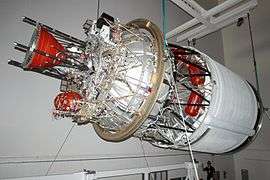Delta Cryogenic Second Stage
 A 4-meter DCSS from a Delta IV Medium | |
| Manufacturer | Boeing IDS United Launch Alliance |
|---|---|
| Country of origin | United States |
| Used on | Delta III Delta IV SLS Block I |
| Launch history | |
| Status | Active |
| Total launches | 21 |
| Successes (stage only) |
18 11 Delta IV 4m 7 Delta IV 5m |
| Failed | 2 (Delta III) |
| Lower stage failed |
1 (Delta III) |
|
| |
| Delta III second stage | |
| Length | 8.8 meters (29 ft) |
| Diameter | 4 meters (13 ft) |
| Empty mass | 2,480 kilograms (5,470 lb) |
| Gross mass | 19,300 kilograms (42,500 lb) |
| Engines | 1 RL10B-2 |
| Thrust | 110.1 kilonewtons (24,800 lbf) |
| Specific impulse | 462 seconds |
| Burn time | 700 seconds |
| Fuel | LH2/LOX |
| Delta IV 4-meter stage | |
| Length | 12.2 meters (40 ft) |
| Diameter | 4 meters (13 ft) |
| Empty mass | 2,850 kilograms (6,280 lb) |
| Gross mass | 24,170 kilograms (53,290 lb) |
| Engines | 1 RL10B-2 |
| Thrust | 110.1 kilonewtons (24,800 lbf) |
| Specific impulse | 462 seconds |
| Burn time | 850 seconds |
| Fuel | LH2/LOX |
| Delta IV 5-meter stage | |
| Length | 13.7 meters (45 ft) |
| Diameter | 5 meters (16 ft) |
| Empty mass | 3,490 kilograms (7,690 lb) |
| Gross mass | 30,710 kilograms (67,700 lb) |
| Engines | 1 RL10B-2 |
| Thrust | 110.1 kilonewtons (24,800 lbf) |
| Specific impulse | 462 seconds |
| Burn time | 1125 seconds |
| Fuel | LH2/LOX |
The Delta Cryogenic Second Stage (DCSS) is a family of cryogenic rocket stages used on the Delta III & Delta IV rockets, and which is planned to be used on the Block I Space Launch System. The stage consists of a cylindrical LH2 tank structurally separated from an oblate spheroid LOX tank. The LH2 tank cylinder carries payload launch loads, while the LOX tank and engine are suspended below within the rocket's inter-stage. The stage is powered by a single Pratt & Whitney RL10B-2 engine,[1] which features an extendable carbon-carbon nozzle to improve specific impulse.[2]
Delta III
The first DCSS variant flown was on the Delta III, performing on 2 out of 3 flights. An un-flown example is on display outside the Discovery Cube Orange County.
Delta IV
On the Delta IV, depending on variant, two different versions are flown. Composite interstages used to mate the first and second stages together accommodate the different configurations.[2] For the Delta IV-M, a tapering interstage narrows down in diameter from 5-meters to 4-meters is used on the 4-meter DCSS, while a cylindrical interstage is used on the 5-meter DCSS.[2]
ICPS
The Interim Cryogenic Propulsion Stage (ICPS), a modified DCSS, will be used as a second stage on the debut flight of NASA's Space Launch System,[3] Exploration Mission 1 (EM-1), scheduled for December 2017.[4]
References
- ↑ Robert A. Braeunig (2 November 2009). "Space Launchers—Delta". Rocket and Space Technology (braeunig.us). Retrieved 26 January 2012.
- 1 2 3 "Delta IV Payload Planners Guide" (PDF). United Launch Alliance. September 2007. pp. 1–5 to 1–6. Archived from the original (PDF) on 22 July 2011.
- ↑ Chris Bergin (4 October 2011). "SLS trades lean towards opening with four RS-25s on the core stage". NASASpaceflight.com. Retrieved 26 January 2012.
- ↑ "Evolving plans: No human rating for ICPS for SLS EM-1 mission". NASASpaceflight.com. April 28, 2014. Retrieved July 2014. Check date values in:
|access-date=(help)
